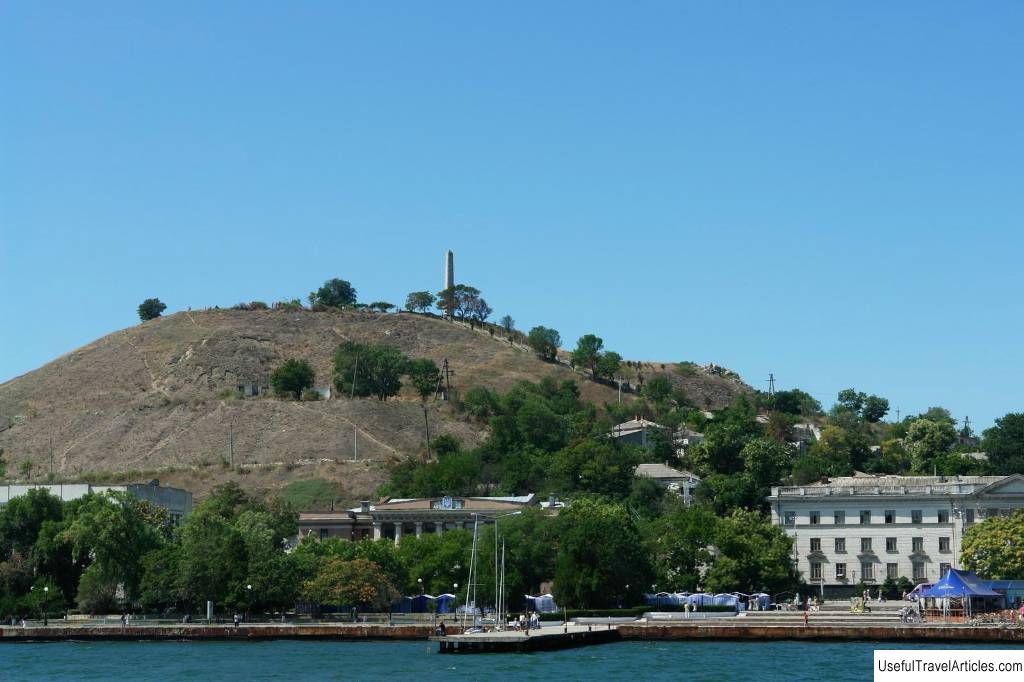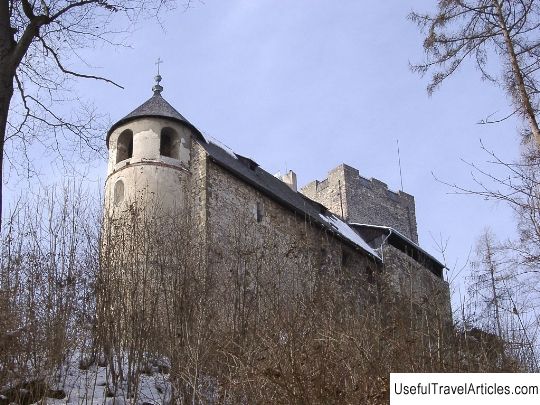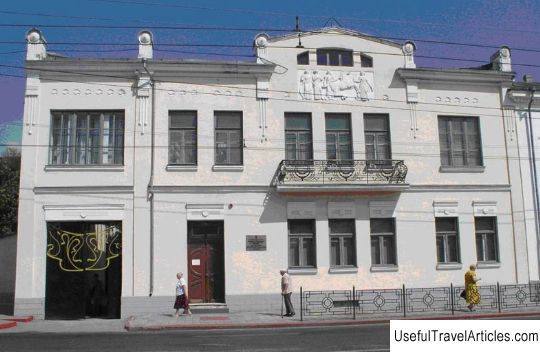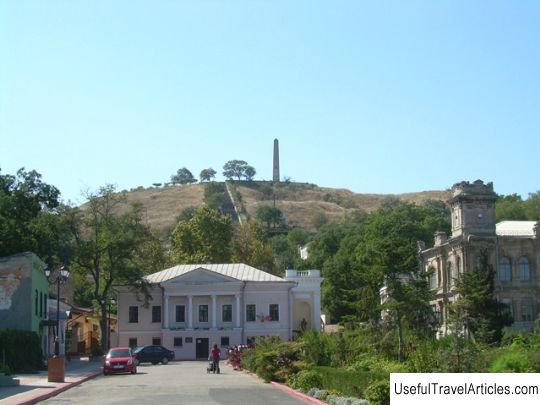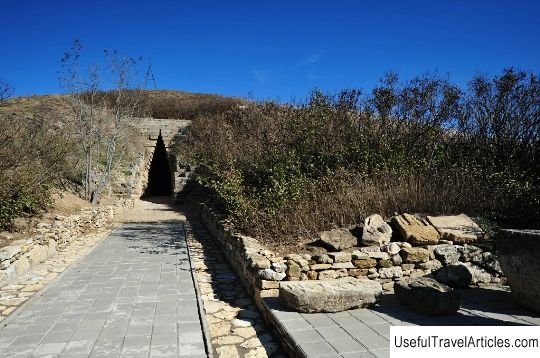Ruins of the ancient Panticapaeum description and photos - Crimea: Kerch
Rating: 8,1/10 (543 votes) 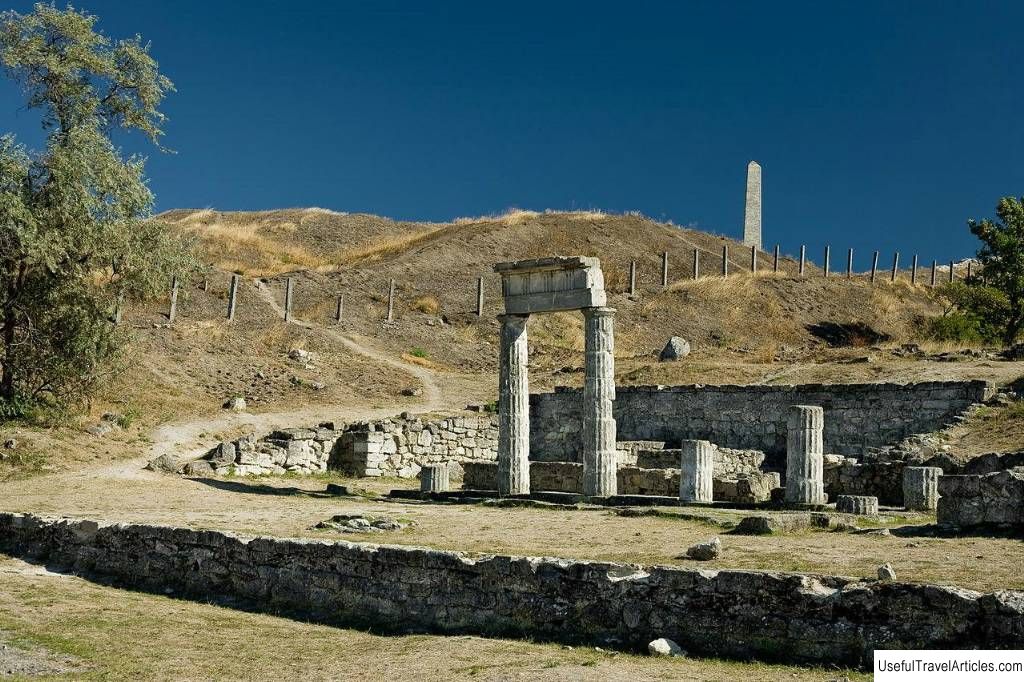
Ruins of ancient Panticapaeum description and photo - Crimea: Kerch. Detailed information about the attraction. Description, photos and a map showing the nearest significant objects. Photo and descriptionThe open remains of the antique Panticapaeum, the capital of the Bosporus kingdom, are located in the very center of Kerch on Mount Mithridates. The view from this mountain to the sea and antique columns is the hallmark of the city. The Bosporan Kingdom and the history of PanticapaeumThe first Greek colonies appeared in Crimea in VIII century BC. , and in the 5th century BC. e. some of them united against the Scythians around the largest - Panticapaeum. This union gave rise to the Bosporus kingdom. Panticapaeum was once founded by immigrants from Miletus , but the inhabitants of the city themselves said that the founder was the son of the Colchilian king Eetus , the one who kept the golden fleece. At first, the Bosporan Kingdom was a union of independent cities. It was ruled by archons, elected rulers. The first of these was the Archeanact , the head of Paneticapeia. He traced his family back to the Milesian nobility. Gradually, the power of the archons began to be inherited, and the next dynasty - Spartokids - was royal. The kingdom expanded. The plans of the Spartokids were to make the Black Sea their own, that is, to seize the entire coast. The city itself grew and grew richer, they minted their coins here - first silver, and then gold. The center of the city was a high mountain (now it is called Mithridates ), on it were found the remains of a huge Temple of Apollo , and in the city itself - fragments of grandiose statues of the gods. The layout of the city was interesting - it differed sharply, for example, from the layout of Chersonesos. Usually, the Greeks built their city-states according to a very clear plan, with a grid of square blocks and parallel streets. But Panticapaeum is more reminiscent of medieval cities - it is located on terraces rising around the central mountain . Some of the city walls and towers were hewn right out of the rock. On the upper terraces and on the acropolis were the houses of the nobility, stone and faced with slabs of colored marble. On the lower terraces and outskirts of the city, there are many structures that are associated with trade and production. These grain warehouses, huge tanks for salting fish, pottery workshops, wineries with wine presses and vats - all this speaks of wealth and prosperity. This time includes the city was mentioned by the famous geographer Strabo (the turn of the 1st century BC and the 1st century AD). Strabo himself was from the Pontic nobility, although his ancestors had long since moved to Rome. He writes about a city that surrounds the mountain in concentric circles and a larger port with 30 ships. In the east, by the 1st century BC. e. a competitor has grown - a strong Pontic kingdom . When the last Bosporan king was ready to transfer power to the king of Pontus Mithridates, the population revolted. The ruler for some time was Savmak , a Scythian by origin. But he did not rule for long, and soon the Bosporan kingdom was conquered. Mithridates IV conquered Colchis, Cappadocia, southern Greece and eventually came into conflict with Rome. There are three Mithridates wars in total - great clashes between Rome and Mithridates. The last of the wars ended just in these territories: part of the cities of the Bosporus kingdom, with the approach of the Roman troops Gnaeus Pompey , fell away from Mithridates and rebelled. In the end, his own son, Pharnaces , took up arms against the king. Panticapaeum crowned Pharnaces, and Mithridates committed suicide in the temple on the mountain - this gave her the name. Pharnacs entered into an alliance with the Romans, annexed the cities of Crimea back. But he wanted to continue his father's work and restore his kingdom within the old borders, so he also came into conflict with Rome. In Panticapaeum, the ruler remained - Asander , and Pharnace himself went to a new war. He took advantage of the fact that Rome was busy with internal turmoil. At this time, Gnaeus Pompey and Julius Caesar just fought for power over the Eternal City. Pharnaces meanwhile occupied part of the Roman possessions in the Caucasus and Asia Minor. Returning from Egypt, after the assassination of Pompey, Caesar sailed not to his native Rome, but immediately to Asia Minor. In 47 BC. e. there was a battle near the city of Zela. It was on the basis of its results that Caesar uttered his famous: “I came, I saw, I conquered” - the victory was so easy. Farnak fled back to Crimea. There it was discovered that his governor Asander no longer recognized his authority, but proclaimed himself the Bosporan king. Pharnaces died in the battle with Asander, and the Bosporan kingdom again entered into an alliance with Rome. Finally, the Bosporan kingdom lost its independence only under Nero. The city, which has ceased to be the capital, is gradually beginning to decline. It was conquered by the Ostrogoths in the 2nd century, and it turns into ruins after the invasion of the Huns in the 4th century AD. e. Only after two hundred years of desolation in these places life begins again. The Byzantines erected here the fortress of Bosporus , then it passed to the Genoese (it was a colony that they called Vospro), then to the Turks. The old fortress was destroyed, and at the beginning of the 18th century the Turks built a new one, around which modern Kerch arose. Necropolis The most famous part of the archaeological sites is the Panticapaeum necropolis . It stretched for several kilometers from the outskirts of the city. Here they were preserved as ordinary burials - pits, in which the deceased was placed with equipment, and burials of the nobility under the mounds. The necropolis contains several burial mounds of the IV-III centuries. BC er . more than ten meters high, and many much smaller ones. Under these mounds are stone crypts with stepped arches of well-hewn stones. Inside were sarcophagi, often richly decorated. Many different utensils were placed in and next to them - now the finds from these tombs make up most of the museum collections in Crimea. Lots of gold found here. Golden wreaths were put on the heads of the noble deceased; in women's burials there are gold earrings, rings and necklaces. Jewelry testifies to a very developed trade - for example, many amber jewelry was found. Many painted utensils, alabaster vessels, terracotta sculptor. Weapons were laid in men's burials, bronze mirrors in women's burials. By the utensils and features of the decorations in these rich graves, one can clearly trace how the original Greek population gradually mixed with the Scythian-Sarmatian: the forms of weapons, ornaments, decorative elements change. The main attraction of the necropolis is Tsar's mound of the 4th century BC er . In a sense, this is the closest analogue of Egyptian tombs: it was opened in the 19th century (in 1837), and it was already completely robbed. Its former interior decoration can be judged only by the rest of the burial mounds, which are better preserved. But on the other hand, it can be used to judge the genius of the Panticapaean architects. The inner vaults of the crypt were made by dry masonry: the slabs were not fastened with any mortar, they are simply hewn so precisely that they fit perfectly together. Another object that belongs to the necropolis, but is located under the very Mithridates in the center of the city - "Crypt of Demeter" . This is a small burial chamber, which was discovered by the Kerch bourgeoisie in 1890 during the extraction of stone from the mountain. It has preserved frescoes and utensils. One of the frescoes depicts the goddess Demeter in blue clothes - this gave the name to the place. The unique frescoes remained unchanged for many hundreds of years, but began to collapse rapidly when the premises were opened. Before the war, they were restored, and during the Great Patriotic War, they again found themselves on the verge of death: a bomb shelter was built here. Already in the 21st century, the images were restored. Now tourists have access to an exact copy of the crypt with all the frescoes and a small museum exposition. Archaeological excavations Part of the ruins of the ancient Panticapaeum, open for tourists, is located on Mount Mithridates. The first excavations here began in the 19th century . According to ancient descriptions, they knew about the once great city and wanted to find the tomb of the famous king Mithridates, but no one knew its exact location. However, everything indicated that there was once a large city near Kerch. Local peasants used antique ruins for their houses; one could easily find a piece of the wall or a slab under the door, decorated with ancient reliefs. There were legends about the mounds that store gold. The first scientific, not amateur, excavations began in 1859 . They dug both the city itself and the necropolis. Both antique burials and Christian burials were discovered, part of the city buildings, the remains of temples. The excavations had to be guarded so that they would not be plundered - after all, ancient antiquities were highly valued, and their sale constituted a considerable part of the income of the inhabitants of Kerch. The treasure hunters were fined, but it was impossible to stop them. Nowadays, many foreign museums possess collections of antiques that were taken out from here before the revolution. At the end of the 19th century, the Kerch Museum was organized, in charge of the excavations. Now archaeological finds from tombs and from the territory of the city are presented in the museum. And in order to inspect the open area, you will have to climb Mithridates staircase , which is a landmark in itself: it was built in 1833-1840. The staircase has three tiers and 432 steps and, as it were, repeats with its outlines the terraces of the ancient city. On the other side of the mountain there is a Small Mithridates staircase , built in 1866 The entrance to the mountain is free, and in the summer archaeologists work here, so you can be lucky enough to observe the excavation process. Interesting factsLocal residents are still sure that a golden horse is buried under the mountain, which once belonged to Tsar Mithridates. During the war from the Kerch Museum a suitcase with gold and silver finds from Panticapaeum disappeared, they are still looking for it. Notes
           We also recommend reading St. John's Monastery on Karpovka description and photos - Russia - St. Petersburg: St. Petersburg Topic: Ruins of the ancient Panticapaeum description and photos - Crimea: Kerch. |

